#Irish Potato Blight
Explore tagged Tumblr posts
Text
I get why potatoes are popularly associated with Ireland and to a lesser extent other parts of Europe, but it's a bit messed up that most people will think potatoes were originally cultivated in Ireland and not ancient Peru and Bolivia like they actually are
#the humble potato. blessed be to a common starch i can actually eat#food#food history#don't quote me on this but I'm p sure one of the contributing factors of the Irish potato famine was bc taters AREN'T native to Eire#and when this foreign crop replaced native staples it was less resistant to the diseases of Ireland#i don't remember off the top of my head if potato blight originated in Ireland itself or was imported with the potatoes#but the fact that Ireland no longer had native crops for the people to eat was a major factor#unless you were lucky enough to live on the Irish coasts and harvest seaweed
25 notes
·
View notes
Text
Black47back
Potatoes blight-smothered Bright uniformed enforcers Turfing out sunken Mothers Brother killing brother Proddie oaths uttered Eating weeds stifling hunger Brits living it up Legs up at the Ritz Taigs taking the sip Of traitor’s soup Trains of troopers Trained for rural evictions Such scenes lately fixtures Long fissures, spuds dead in lazy beds Country is a crypt In famine’s…
#alchemisland#am writing#art#black 47#creative writing#dark#darkness#depression#dublin#famine#feelings#gothic#history#horror#hunger#imagination#ireland#irish#irish famine#neuralchemy#OC#poem#poet#poetblr#poetry#poetryblr#potato blight#potato famine#spilled ink#words words words
2 notes
·
View notes
Link
0 notes
Text


sorry but this is important. in a globalized world with more than enough food for all crop failures do not need to lead to starvation.
the world food program estimates it would cost about $40 billion to end global hunger for a year. less than a quarter of elon musk’s current net worth, or less than half of what joe biden has spent funding the genocide of palestinians.
even if there was not enough food to feed everyone, as may happen with climate change and ecological collapse, the choice of who does and does not eat will always be political. the distribution of power is the definition of politics, and that includes the power to eat.
remember that during the irish ‘famine’ ireland was a net exporter of food. it was the bread basket of england. it was only the potatoes that the irish relied on for subsistence that failed. and i’m pretty sure even the blight itself was political, a result of human monocultural farming practices. potatoes aren’t even native to ireland, or europe.
1K notes
·
View notes
Photo
If that 611% figure for Ireland is making you scratch your head, it's because Irish people who left Ireland for the US in the 1840s had a vastly higher survival rate than Irish people who stayed in Ireland through that period. 180 years later, Ireland's population is still lower than it was in the 1841 census. Yes, that is remembering to combine the numbers for Northern Ireland and the Republic.

Self reported ancestry survey in the US of how many people say they have ancestry from that specific nation (relative to the nations population).
#maps#ireland#europe#for the record my last irish ancestor left the island well over a century before the potato blight#i am cajun and my ancestry is mostly french
123 notes
·
View notes
Note
I have a question I just thought of. I remember reading that the potato is something that you can discuss at length. I'm curious about the Irish potato famine (as it's called by many people) of 1845 - 52. The potato blight killed a whole load of potatoes, and blight warnings are still a thing today. But... honestly, why? Was just one variety of potato grown? If not, wouldn't different varieties have resisted? The only thing I'm even remotely familiar with is Panama Disease, which is killing off Cavendish bananas because they're all genetically identical - was that the case for the potatoes being grown at the time?
Oh boy. Okay, this is a huge complicated topic and I can only do the Cliff Notes version and even that is absurdly long, but here we go.
The cause of the Irish Potato Famine were, in order:
A) the British
B) the British but moreso
C) still the British but also capitalism
and
D) monoculture
I am not nearly so equipped to talk about A-C as many, many other people, so let’s talk about D.
Now, the humble potato is frankly one of the most glorious products of agricultural science ever created, for which we must thank the indigenous people of Peru, who produced some goddamn geniuses at potato breeding (and also figured out how to freeze-dry potatoes centuries before Idahoan.) The Incas had literally thousands of potato varieties, every size, shape, color, growing condition, right down to sacred potatoes only for consumption by the royal family. They did seriously epic shit with a weird little tuber, a feat perhaps only surpassed by the geniuses who made corn out of teosinte.
Quite a long time later—by which I mean about ten thousand years after the potato was domesticated—the Irish were growing a potato variety called the Lumper. It was a big, coarse, ugly-ass potato which apparently didn’t even taste that great. Irish farmers had other potatoes that they liked a lot better! But the Lumper had three things going for it—it gave huge yields, tolerated nutrient-poor soil, and it didn’t mind wet feet.
(Wet feet is the gardening term for plants with their roots in waterlogged soil. Most potatoes do not actually like wet feet and will rot. But the Lumper was fine with it, which meant that basically you could grow the things in poor soggy soil, which large swaths of Ireland had in generous supply.)
Because of a whole lot of really abusive shit by various landowners, a lot of Irish people ended up dependent on the Lumper for their diet, and I mean dependent. You can live for a really long time on cow’s milk and potatoes if you have to, and a potato that would produce massive yields in crappy wet soil was a godsend. So you had vast areas that were planted with just the Lumper. (There are some reports that other, better-tasting potato varieties were grown for the landlords, but while the workers dug them, they were not allowed to eat them. I can’t speak to the truth of this or not, but it’s definitely worth looking up a full history of the socioeconomics of the famine, if you ever happen to be feeling too good about the world and want to be crushed.)
Unfortunately, the Lumper has one other significant trait—it is extremely vulnerable to potato blight, a disease caused by Phytophtora infestans, which is a weird little thing called an oomycete. It’s more like a fungus than it is anything else, but it’s actually in a separate kingdom called Chromista. (Currently, anyway. Taxonomy is where idealistic young scientists go to become old before their time.) Nevertheless, for our purposes, let’s just call it a fungus. (Also, Chromista is a great name for an alicorn in My Little Pony.)
P. infestans loooooves members of the Solanum clan, which include tomatoes and potatoes. This love is not returned. In a tomato, it’s usually called late blight, in a potato, it’s potato blight, no matter what you call it, it’s bad news. It likes damp, cool conditions, and of course Ireland is basically one big damp cool condition, so once the blight got established, it was in heaven.
Blight on a potato takes about five days from start to finish. This sucker is FAST. One day there’s a blotch on a leaf, next day there’s some whitish stuff under a leaf, then the tubers are suddenly turning black and mushy and stink to high heaven. You may even think you got a good tuber and put it in storage and then you open the door to the root cellar and the whole bin has rotted practically overnight.
The spores can spread by wind, and once it landed on a potato plant, all it needed was like two days above fifty degrees with high humidity, and it was off and running. And it gets in the soil. But worst of all, it lives in the tubers themselves.
Potato cultivars, for those who don’t know, are almost always a clone of the parent. All Yukon Golds are basically the same Yukon Gold. You pop a tuber off a plant, you pop it in the ground, it grows another plant just like the first one, asexual reproduction at its finest.*
Now, potatoes can and do set seed, but there’s some variation even in a seed with two parents of the same variety. Two Yukon Golds might give you Yukon Goldish. Mix up multiple varieties and you don’t always know what you’re gonna get.** (I have grown potatoes from mixed seed and thus made my own cultivars, it’s fun, but the results are wildly variable. Some don’t set tubers at all, some contain high levels of solanine.***)
If you want specific, uniform varieties that all perform the same way, you probably use the tubers. More importantly, tubers start growing right away once you wake them up, whereas potato seedlings can be finicky and often won’t do anything impressive the first year.
To make matters more confusing, the little tuber clones are referred to as seed potatoes.
Anyway, back to the blight. Everybody was growing from little tuber clones, which could be infected with the blight. This means that if your seed potatoes are infected with blight, even if they look fine, if you plant them, your whole crop is infected. The minute you get a cool wet day, the oomcyte wakes up and goes to town. And if you leave an infected potato in the ground, it infects everybody else—and if you’ve ever dug potatoes, you know that you always, always miss one.
Well. The blight came, it hit the Lumper, and it spread like wildfire. The Lumper grew in the wet conditions the blight loved, and was also really susceptible to it, so it was a match made in hell. There were potato varieties even then that were more resistant to the blight, but they were tiny islands and a sea of blight was washing over them daily, so they eventually succumbed. Even if you planted a different potato, if it was in soil that had previously held the Lumper, it was likely doomed.
This is the problem with monocultures. You plant all one variety and it’s susceptible to some particular bug, when that bug hits, you have no fall back position. And potatoes, being more or less clones, are even more vulnerable than most seed-grown crops, and this bug is particularly nasty and the spring of ‘45 was exactly the right weather and the British government was being particularly evil and ultimately a million people starved to death because of a perfect storm.
The Lumper still exists. Somebody turned up some heirloom seeds back in 2008 and grew them out, and what they got is probably pretty close to the original. Being seed grown, it doesn’t carry the blight. It’s an ugly, watery, kinda waxy potato that even its champions think tastes sorta okay, I guess. Cultivariable, one of the few sources I can find, says that in addition to not being resistant to blight, it’s not resistant to anything else either, and there’s not much point in trying to grow it unless you have long dry summers and no local blight.
And that is the saga of the Lumper, the blight, and why I personally always plant at least four varieties of potato.
* There’s some subtleties here, but for layman’s purposes, we’ll go with this.
** It’s actually way complicated, but this is already hella long.
*** Same stuff that makes green potatoes toxic. Super bitter, so you know right away it’s inedible and spit it out. We still refer to taste-tasting the new crop from seed as “the Potato Suicide Pact” but it’s not actually dangerous.
1K notes
·
View notes
Text
It's the 17th of March, so y'know what that means-

Happy Saint Patrick's Day to you all! I know the majority of you probably don't celebrate, which is fair, BUT I decided I wanted to talk a little more about the country I was born and raised in- the Emerald Isles of Ireland!! :D
If you're just here for the art, well here ya go! However, if you want to learn more in a VERY long post:
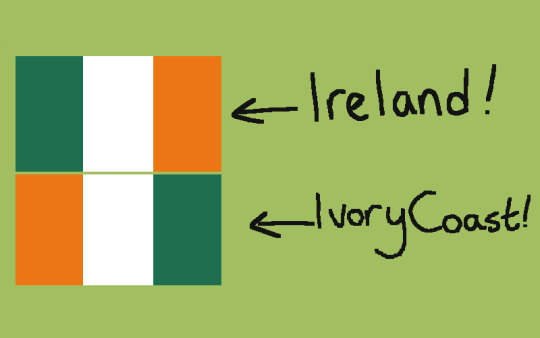
Just to start off, here's the Irish flag and the Ivory Coast flag! Wanted to add this because they can get easily mixed up (I got them muddled up a LOT when I was younger-)
Since it is Saint Patrick's Day, I should probably elaborate what that's about- what I've been taught in school is that Saint Patrick preached the Gospel to the Irish, one method including the shamrock to represent the Father, the Son, and the Holy Spirit. Of course, and the whole "he drove the snakes out of Ireland" but don't worry. There are still snakes in Ireland. And I'm pretty sure "snakes" is a metaphor anyway. And, turns out, he wasn't even originally from Ireland- he was British! Oh yeah, and he was kidnapped by pirates to become a slave when he was a teenager for 6 year s -
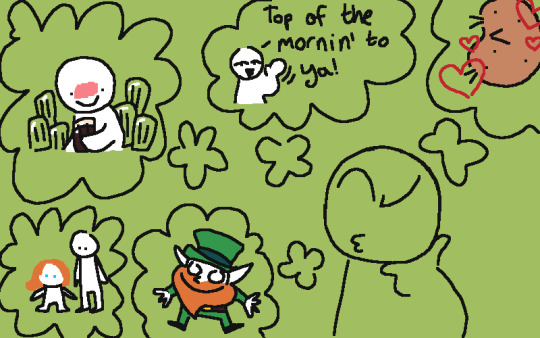
Here are some stereotypes or the first things that pop into your mind when you think of "Ireland"- leprechauns, short gingers, "Top of the mornin' to ya" and our love for spuds and beer. And, to tell you some stuff about them too!
Leprechauns originally wore red! They pop up in fairy tales quite often too.
Ireland is second when it comes to having the highest percentage of gingers with 10%, with Scotland having 13%. As for being short, I reassure you, there are plenty of tall and/or lanky people around. (A lot of my teachers are like this-)
I've heard no one say this as a greeting. The only Irish person I can think of who does is Jacksepticeye. You might be more likely to hear "How's it going?" or "What's the crack?"
As for loving beer, we are one of the highest consumers for it, but there are many other higher consumers! Also, I don't know if this is a thing in America or not, but we tend to call them pubs. Bars are a bit more...fancy? I don't know how to describe the difference.
And for loving potatoes? Okay. This is probably true lol. Almost everyone I know likes potatoes (with some exceptions). And, of course, who can forget the Great Famine when blight destroyed the potato crop and killed around a million people- spuds were a huge source of food back then.
And now, for language! Here are some I'm used to hearing quite regularly (and use often, too!)

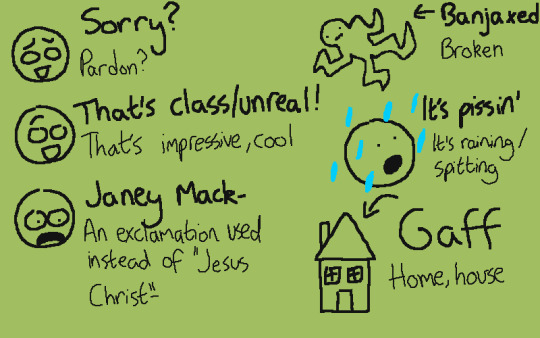
Another two that I want to add are more Cork exclusive, but saying "boy/girl" at the end of sentences and using "like" a lot is quite common (especially the like one- I say "like" all the time ;v;).
And now, Irish itself! Now, I'm not going to tell you anything major (I'm not a teacher) but I will try my best to explain a little!


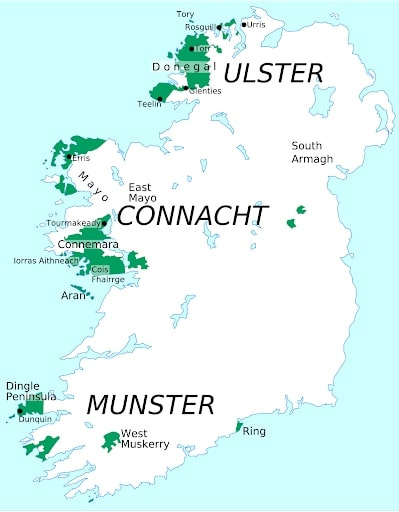
Irish is not the main language of Ireland but in some particular areas (shown in the right image) there are regions called Gaeltacht districts which predominantly speak Irish. Their Irish would be a lot better than my school-knowledge based Irish :'D Another thing to add is that different provinces (the provinces shown in the middle image) have different versions, or pronunciations of some words. Being from the province of Munster, I've been taught the "Munster" pronunciations and words.

So..."Tá mé éan sásta" would mean "I am a happy bird" :D

I apologise for how messy my writing looks-
OKAY. ONE MORE THING I WANTED TO COVER IN THE IRISH LANGUAGE IS THE NAMES, because I've seen plenty of people online and in real life joking lightheartedly how hard Irish names are pronounced. So here are some Irish names!!
Saoirse - this one is brought up quite a bit- It can either be pronounced as "seer-sha" or "sair-sha"!
Róisín - "roh-sheen" !
Eoin - even I had a hard time pronouncing this when I was younger- it's pronounced as "owe-in" like "owing" but without the g!
Fódhla - I remember this appeared in the newspaper once and a family member was baffled by it- it's said as "foh-la" :]
Another I want to mention is Eilish- you probably know it thanks to Billie Eilish, which is pronounced as "eye-lish"- but it can also be pronounced as "eye-leesh"!
Last one, Sinéad- you may have seen this one once or twice as is pronounced "shin-aid" :D
And now, some more quick stuff!!
Musicians from Ireland!!


On the left you have Hozier (love his music!! :D) and the right is the Cranberries!!
Some other Irish artists you may be familiar with are U2, Thin Lizzy, Westlife and Sinéad O' Connor!


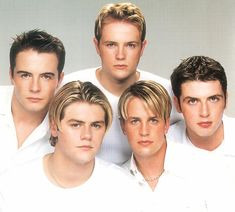

Some popular Irish snacks!!


crisps/chips!! (I love em both dearly)
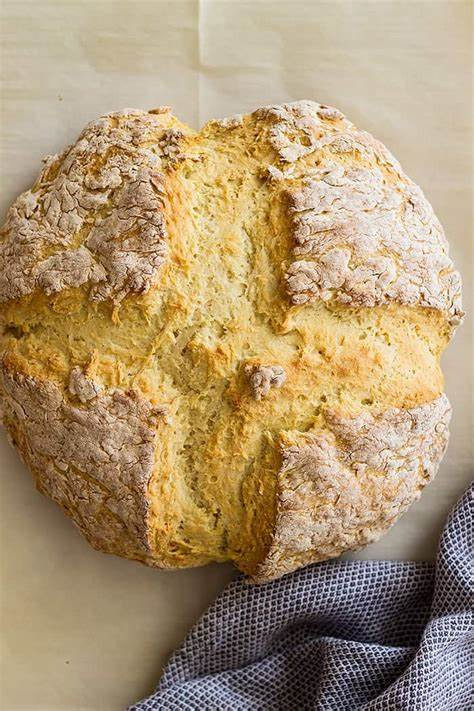

of course, how can I not bring up Irish bread: soda bread and blaas :D


Hot chicken rolls!! (seriously how are these not more popular elsewhere-) and spice bags!! (chips with spices, peppers. maybe chicken)
Animal wise, we haven't got anything too crazy, but we do have one of the largest breeds of dog, the Irish greyhound and the now extinct largest deer, the elk.
I think I'm beginning to run low on space, so I'll end it there!! If you're also Irish, free to add on facts/words!!
I don't usually say this but I would kinda appreciate reblogs since I felt like I put a bit more effort into this ;v;
So uh, yeah- Happy Saint Patrick's Day!! :D
79 notes
·
View notes
Text
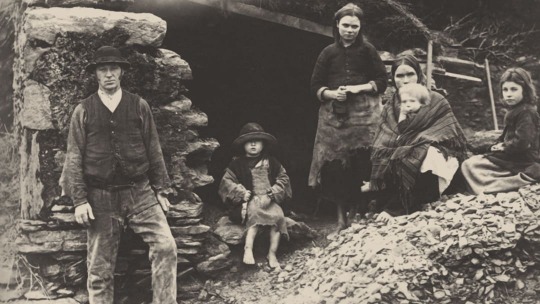
It's that time of year when you are going to see some "Irish" t-shirts in stores and can get your Shamrock Shake at Mickey D's. There will be St. Patrick's Day parades this weekend and next.
And I just want to be a nerdy know-it-all for a second. St Patrick's Day was originally a religious holiday (as most holidays were, holy + day = holiday); it still is in some places, like some actual Irish people from Ireland who believe in God--though the American parade/festival mentality seems to be gaining steam in some parts of Ireland, I am told.
St Patrick's Day as we know it is deeply rooted in the United States. Though it's been celebrated here since 1600 in the territory that became Florida, the tenor of the holiday greatly changed after the Great Famine of Ireland.
You may have been told in school that the famine occurred because a blight wiped out potato crops in Ireland. This is true but doesn't address the crux of the matter.
The blight started in North America and travelled to Ireland and into much of Europe. But we only think of it as an Irish problem because the Irish were too poor to eat other foods.
Some scholars have said it was a "man made crisis" and I agree that is true. Other crops in Ireland were not affected by the blight, in fact, this time was considered one of "plenty", but all that food was used to feed the English. Not the Irish.
Nor were the English quick on providing aid, "There is such a tendency to exaggeration and inaccuracy in Irish reports that delay in acting on them is always desirable," said Prime Minister Sir Robert Peel after initial reports of the catastrophe.
Workhouses designed to assist the poor and starving were closed prematurely. "The only way to prevent the people from becoming habitually dependent on Government is to bring the food depots to a close," said Charles Trevelyan, the man who was literally in charge of famine relief. He also said some gems like, Sure the famine is bad but "the moral evil of the selfish, perverse and turbulent character of the people" was the real problem. Great guy; he became a Baronet.
The soup kitchens, which replaced the workhouses were also closed prematurely, were widely believed to serve portions too small even for children and lacking any nutritional value due to them being watered down to feed more people than anticipated by the brilliant British government.
A million people died in Ireland from famine and disease and nearly 2 million left Ireland for other parts of the world. Including my father's family. (If they survived the "Coffin Ships" leaving their home.)
So when I said above that the tenor of the holiday changed, it was because of increasing Irish Nationalism and anger at Britain. Now, Ireland is a Republic (though it's not unified, yet) and we are proud of those who stayed and fought to make that happen.
We are also proud just to still be alive anywhere. The population of Ireland is 6.9 million now--slowly nearing the 8.5 million it was home to before the famine--but people with Irish ancestry across the world has been measured to be about 80 million people. Take that, Sir Robert Peel.
The English actively tried to kill us. Nevertheless, we persisted. A lot.
I hope you have a Happy St. Paddy's Day (it's Paddy not Patty). Drink some Guinness. Dance some jigs. Definitely eat some potatoes (Boil 'em! Mash 'em! Stick 'em in a stew!) But please remember that when people are starving, you should feed them. Don't be like the English government.
In fact, as I write this there is a crisis in Turkey and Syria. It just so happens that the Sultan of Turkey wanted to donate money to Ireland (10,000 pounds) but since Queen Victoria donated just 2,000, he was told it would be against protocol.
#st patricks day#saint patrick#ireland#irish american#the great famine#irish potato famine#st paddys day#turkey#turkey earthquake#syria earthquake#immigration#sir robert peel#england#queen victoria#Charles Trevelyan#republic of ireland#nothern ireland
194 notes
·
View notes
Text
Oh this is really good post because it is adding some nuance to something that has gotten really oversimplified.
I might be able to add a little more nuance:
I grew up in an ag region in the U.S. so a lot of what was going on was familiar to me when I lived in Ireland in the 1990s, but there were some surprising differences.
First of all Ireland if is very rural and it was not unusual to see people using tractors as transportation and even horse drawn carts. I lived in Dublin and there were still farmers bringing produce into Moore Street market by horse and cart in the mid 90s. So yeah getting food from one place to another was difficult in the 1840s. The only rail lines ran between Dublin and Waterford in the south and Limerick in the South west, that left all of the north and northwest with slow coach roads. It would take days to cross the country with supplies. Famine relief in the worst effected areas would be a logistical nightmare.
In Donegal I once hitched a ride on a farmer's tractor from a hiking trail on Sliabh Liag that was miles from any town and at a really quite high elevation. The farmer was planting potatoes up there! I was shocked. I had no idea they grew at that elevation. (Potatoes are a genetic engineering marvel that grow in almost every conceivable environment depending on the species etc.). This is land that I venture no one in the U.S. would be bothering to farm. It's just too inaccessible and the conditions too difficult for moving your product to market. The soil is also rocky af. The old joke about why there are so many walls in County Mayo is that it was because they were clearing the fields and needed someplace to put all the rocks.
But if you are eating what you grow (i.e. potatoes) it's fine and there is even some advantage in the inaccessibility as it is a lot of work to raid your garden.
If you are growing oats, wheat, barley as your rent on some bottom land, you have no means of processing that stuff into food. You can't just eat a handful of raw oats. You need mills. Now mills were not everywhere around the Irish landscape. They were near towns and would be owned and run by the same people that were landlords. It took capital to build and run them and poor subsistence farmers did not have capital. So they really had no choice but to give over their rent crops because fat lot of good it would do to keep them and try to eat them, and then as OP says, you'd get evicted and starve anyway after you lost your house and possessions.
When you visit rural Ireland you see in every town and every village markers for mass graves from the famine. It was everywhere and so disastrous that historians do not have an accurate death toll because so many were buried so hastily.
Like all famine, the Irish Famine was man made. And there is no question that the numbers killed would qualify at it as a genocide. That only leaves "intent" and there is plenty of evidence for that too. That there was never a stated policy by the British government to wipe out the Irish at the nearest opportunity seems like kind of a formality to me...

Can I be extremely pedantic for 1 moment and say that I hate this post even though it's technically not completely incorrect because it completely ignores. like. everything. about the things in pre famine ireland which led to the famine in favour of making it seem like this was something which just happened with nothing on either side which led to it. also it sounds like it was written by john mitchel
#shout out to 1990s sinead o'connor telling the irish diaspora in america: the famine wasn't caused by the potato blight...#there was plenty of food --it was taken out of ireland under armed guard#she was saying this between songs at her concerts...this was pre ripping up pictures of the pope#and like that is a simplification but the fact that most of diaspora saw it as a result of the potato blight was the point she was making#and like all revisionist history the revisionism gets oversimplified#and then needs re-revisioning
147 notes
·
View notes
Text
Bram Stoker and Irish independence
I keep seeing posts popping up in the Dracula Daily tag about Bram Stoker being Irish, implying that we can draw conclusions from that about his politics, his attitude towards Britain, or the British Empire as a whole. I thought it might be useful to provide a bit of context.
Standard disclaimer: I'm not a historian and this period of Irish history is very complicated. I'm going to do my best but this will be a simplification, because otherwise an already long post would become a novel.
Less-standard disclaimer: I'm only going to go into some of Bram Stoker's views here. Others, such as his egregious racism, obviously also have a bearing on his views on empire... but again, a novel.
A very brief history of Ireland in the 19th century
god i have no idea how to simplify this
OK let's go. At the start of the 19th century, Ireland was a primarily Catholic, Irish-speaking country ruled by a primarily Protestant, English-speaking minority. The bulk of the Irish population faced colonial discrimination in a host of different ways, from restrictions that promoted English trade over Irish trade to laws that restricted Catholics from holding public office. The result was a long series of rebellions and risings against British rule, most recently in 1798. Though there was slow progress towards Catholic emancipation, especially in the 1820s.
In the 1840s, a potato blight affected the Irish staple potato crop. The British response - providing very little in the way of famine relief and continuing to export other crops from Ireland to Britain - turned a natural disaster into a genocide. A million people died and roughly twice that number emigrated. Ireland has yet to recover to its pre-Famine population.
A long-term consequence of the Famine was the decline of the Irish language. Irish-speaking areas were among the worst affected, and by 1900, Ireland was majority English-speaking. Another contributing factor was establishment of National Schools from the 1830s onwards, in which students were prohibited from speaking Irish.
In the second half of the 19th century, different movements arose to address these problems. There were campaigns for land rights, to protect tenant farmers; there was a movement to revive Irish culture and the Irish language; and there were different campaigns for how Ireland should be governed.
Independence was advocated for by groups such as the IRB, who supported taking up arms for complete freedom from the British Empire. Among the landed middle classes who were able to vote, this was a fringe position in the second half of the 19th century.
Home Rule was the idea that Ireland should remain in a union with Britain, under the British Crown, but that an independent Irish government should have complete control over domestic matters. This was the mainstream nationalist position in the late 19th century, and was the position of most of the Liberal Party in the UK.
Unionism was support for the status quo, and opposition to any devolution of power to Ireland. This was the position of the Conservative (Tory) Party in the UK.
In elections in the 1850s, Irish voters (male landowners only) were relatively split between Liberals and Tories. But by the 1870s, even this unrepresentative group of people voted overwhelmingly for the new Home Rule Party and its successor the Irish Parliamentary Party. That remained the majority view of Irish nationalists until WW1.
The leader of the Irish Parliamentary Party, Charles Stewart Parnell, persuaded Liberal PM William Gladstone of the importance of Home Rule. In 1886, Gladstone introduced a Home Rule bill to Parliament, but it was defeated in the House of Commons by 30 votes, causing Gladstone to lose power. In 1890, Parnell was revealed through a divorce case to be in a relationship with a married woman, causing a scandal that split his party. In 1893, after Parnell's death, Gladstone was returned to power and attempted a second Home Rule bill, which passed the Commons but was defeated in the Lords.
And that's the context in which Bram Stoker wrote Dracula.
Bram Stoker's views on Home Rule
The starting point is that we don't know a huge amount about Stoker's views on anything. The Irish Times describes him as "so private we know little of his life." Here's a bit of what we do know.
He was a Protestant from a comfortable middle-class background. Here's where he grew up:

He studied at Trinity College Dublin, which Catholics were barred from attending (by their own leadership) on the grounds that attendance constituted "a moral danger to the faith of Irish Catholics." There, he would have been surrounded by committed Unionists; Trinity was its own parliamentary constituency and voted for Conservative MPs long after the rest of Ireland was supporting Home Rule.
At the same time, he was making friends with nationalists such as John Dillon and described himself as a "philosophical Home Ruler". (Source, which is amazingly comprehensive on the events of Stoker's life).
He must have liked that phrase, because when he wrote his Personal Reminiscences of Henry Irving, published in 1906, he was still using it:
We were all, whatever our political opinions individually, full of the Parnell Manifesto [published 1890 after the divorce scandal and attacking Gladstone] and its many bearings on public life. For myself, though I was a philosophical Home-Ruler, I was very much surprised and both angry at and sorry for Parnell's attitude, and I told Mr. Gladstone my opinion. He said with great earnestness and considerable feeling: "I am very angry, but I assure you I am even more sorry." I was pleased to think - and need I say proud also - that Mr. Gladstone seemed to like to talk politics with me...
Above all his admiration for Gladstone, and pride in having him as a friend, shines through in this section.
Different sources interpret what a "philosophical Home-Ruler" is differently. It may be "one who accepted Home Rule as more necessary than ideal" or supporting "Home Rule brought about by peaceful means"; either way, it seems his support for Home Rule was qualified, not full-blooded.
Overall Stoker held a mainstream view, neither adamantly pro-independence nor a defender of the status quo in Ireland. He also seems to have been quite happy to maintain friendships with people who disagreed with him, whether they were Tories or more radically pro-independence.
This is less exciting than takes that I've seen out in the wild, such as "Bram Stoker hated the British Empire and that's why Dracula attacks English people". But it seems to be what the evidence bears out.
96 notes
·
View notes
Text
To understand Ukraine better, think about Ireland
What analogy would help American Catholics understand the situation in Ukraine?
Perhaps we should think about Ireland.
Like Ukraine, Ireland was dominated for more than 200 years by a huge imperial neighbor. Britain in Ireland. Russia in Ukraine. Both nations disappeared from political maps for more than two centuries.
Ireland got its independence from Britain in 1921 after 230 years of domination. Ukraine was finally free of Russian (Soviet) domination in 1991, after more than nearly 300 years of domination. Ukraine had the added problem of more than one colonial ruler, with Poland and Lithuania and Austria in the west, the Ottoman Turks in the south, and the Russians in the east.
Ukraine is a huge country, with relatively level topography, in the middle of Europe. It has been overrun with invaders since the Mongols invaded in the 13th century from the east. Poland and Lithuania dominated Ukraine in the west. In 1686, the Treaty of Eternal Peace between the Polish/Lithuanian confederation and tsarist Russia divided Ukraine in two, with everything east of the Dnieper River and Kyiv going to the Russians. So, beginning in the 1690s Russia dominated eastern Ukraine. They did their best to eclipse Ukrainian culture and referred condescendingly to Ukrainians and "Little Russians." Even the name "Ukraine" is from the Russian perspective. It means "borderland" — and the border is from Moscow's perspective.
Language is an important part of identity. The indigenous languages of Ireland and Ukraine were both suppressed and supplanted by their colonial rulers. Ireland's educated elite spoke English and were sent to England to study. Ukraine's educated elite spoke the languages of their cultural masters: Polish in the west, Russian in the east. Under the tsars and the Soviets, the elites from Ukraine were sent to Russia to study and were expected to become cultural Russians. Today the Ukrainian language is making a comeback, even in the east. In Ukraine, I've met several Russian-speaking Ukrainians who now refuse to speak the Russian language. And Ukrainian is not a dialect of Russian, any more than Spanish is a dialect of Italian. They are distinct.
Both Irish and Ukrainian cultures were preserved in the rural areas. In the countryside, people spoke their native languages at home, in church and among themselves. But in business and in cities they spoke the language of their colonizers, English and Russian. That seems to have been especially true in Ukraine.
While neither Ireland nor Ukraine governed themselves for more than 200 years, their sons were drafted to fight the wars of their colonizers. The people of both nations generally remained poor, while the agriculture of both nations fed their rulers.
Both nations were visited by unnecessary starvation, despite their rich land and agriculture. Ireland had the Great Hunger of the 19th century, brought on by the potato blight and land rents. It killed a million people and sent another million into exile.
In Ukraine, the breadbasket of Europe, at least 4 million Ukrainians starved to death in the 1930s under Joseph Stalin during the Holodomor ("death by hunger"). It was totally unnecessary, brought on by Stalin's policy of "collectivization" of farming and persecution of Ukraine's Culak farmers, who were perceived as anti-Bolshevik. Russian police entered Ukrainian homes and literally took the food from families.
Eastern Ukraine was severely depopulated by starvation, war and political purges by the end of World War II. Russian speakers were brought in to repopulate eastern Ukraine. (That's similar to what the English did in Northern Ireland when they brought in Scots.) This "Russification" changed the ethnic makeup of eastern Ukraine.
World War II was especially cruel in Ukraine. Between 7 and 8 million Ukrainians died in the war; at least 5 million were civilians. The population of the Ukrainian Soviet Republic was 41 million in 1940 and 36 million people in 1950.
Millions of people have emigrated from both Ireland and Ukraine. After World War II, many Ukrainians came to the U.S. and Canada. The Ukrainian Catholic churches that dot our landscape today are testament to their presence here. A new exodus took place from Ukraine in 2022, when about 6 million people left the country as refugees in just a few months. They settled mostly in western Europe. The population of Ukraine had been 41 million before Russia's full-scale invasion began Feb. 25, 2022. Now it is estimated at about 36 million. (No one is sure because a census is impossible to do in wartime.)
Both Ireland and Ukraine have seen severe religious persecution. In Ireland, the British crown banned Roman Catholicism under Irish penal laws. In Ukraine, under the Soviets, all religion — except Orthodox Christianity under the Moscow patriarch — was banned. The state was officially atheist during the Soviet era, 1921 to 1991. Today, as a result of Russia's invasion, the number of followers of the Ukrainian Orthodox Church of the Moscow Patriarchate is declining and the independent Orthodox Church of Ukraine is growing. Whole parishes are leaving the Moscow patriarch. A July 2022 survey by the Kyiv International Institute of Sociology found only 1 of 25 of Ukrainians (4%) identified with Moscow Patriarchate, a considerable drop from nearly 1 of 5 (18%) in June 2021.
Catholics, of both Eastern and Western rites, saw their churches, seminaries, monasteries, convents, schools and universities seized and closed during the Soviet period. Many church leaders had to go into exile. We visited one formerly Latin Rite church in Lviv, built by Polish Jesuits in the 1700s, which had been a book warehouse under the Soviet regime.
The war seems to have promoted the growth and independence of the Ukrainian Orthodox Church. It was recognized as a self-governing (autocephalous) church only in 2018, by the Patriarch of Constantinople (Istanbul). That resulted in the patriarch of Moscow excommunicating the patriarch of Constantinople.
Why is this important for American Catholics? Because I have heard a fair amount of Russian disinformation from American Catholics after our two visits to Ukraine in the last two years.
People ask: Isn't Ukraine really just part of Russia? Answer: No. Not willingly.
Isn't the Ukrainian language just a dialect of Russian? No. It is a distinct Slavic language.
Wasn't Crimea always Russian? No. Catherine the Great seized it from the Ottoman Turks in 1783. Stalin deported most of the local Tatars to concentration camps in the 1930s.
History matters. It helps us to understand the past and deal with the present.
In 1991 Ukrainians took their rightful place among the peoples of the world. It has been a centuries-long struggle to be free of domination by their imperial neighbors. From what I have seen, they are absolutely determined that they will not again disappear from the maps of the world.
#Ukraine#Russia#Ireland#catholicism#America#catholic#holodomor#article#the great hunger#potato famine#russification#Mod note: disappointed they didn't mention the other hypothesis that the name Ukraine means land or country in Ukrainian#But the comparison is interesting and useful at least
7 notes
·
View notes
Note
Ireland is an extremely old country. Our history is long and varied. Each of the four provinces has it's own specific history and mythology. I am from Ulster so I can only tell you what I know.
I'm not sure which parts of history you would like to hear, so I'll start with one thats near to my heart.
The first thing you need to know about the Famine, is that it wasn't a famine. In Irish it's called An Ghorta Mhór (The Great Hunger). A famine is when a country doesn't have food for it's people. There was a lot of food in Ireland. But it was 1845 so we were under British rule and they were (are) greedy bastards.
Years before this, a man called Oliver Cromwell came to Ireland with an army. He went to every city and every settlement and kicked everyone out. He told them "To Hell or to Connacht" meaning they could die or they could leave their homes and flee to the west. Most ran. Many died. The ground in Connacht is bad and hard to farm. You had to plant a lot of a crop to get anything back. Around this time, potatoes came to Ireland. They were easy to grow, filling to eat and you could cook them a million ways. So we planted them and relied on them.
Cromwell and his men stole our land. And then they decided if we wanted to live in our own country, we would have to pay rent. We didn't have money, just our crops, so that's how we paid. Our landlord would gives us some land, say 2 acres, and then would demand all the crops from the first acre should be his. When the potato blight hit Europe, Ireland suffered the most. Even though we had moved away from the rocky terrain of Connacht, we still had to produce huge amounts of crops. We were still growing the potatoes and relying on them.
1845, the potatoes failed. No one could pay their rent. Our landlords did not accept this excuse. Any healthy food was given to them. Irish people starved in the streets, and these English landlords ate three course meals everyday. So obviously we hated them (still do honestly).
There's a lot more to cover on the Famine but I have to go now. This was quite depressing but it's Irish history. Most of it is depressing.
- ⚓☘️


I actually did know that the 'famine' was the fault of the British but hearing the specifics is incredibly sad. Thank you for taking the time out of your day to educate me on it. I've always hated the Brits because they're the biggest colonizers I know. I've also heard of them destroying Irish history as well as other countries' but I don't know much on that.
But thank you, ⚓☘️Anon! I'm very grateful for your help!

5 notes
·
View notes
Text
#OTD in 1845 – The arrival of the potato blight in Ireland is reported in the Dublin Evening Post.
To this day, all over Ireland the landscape bears mute testimony to the events that occurred in the horrific period from 1845–1852. Starvation graveyards offer silent tribute to the millions of Irish men, women, and children buried in unmarked mass graves. Thriving villages were replaced by heaps of moss-covered stones. Although historians have not agreed on the numbers who perished, most…
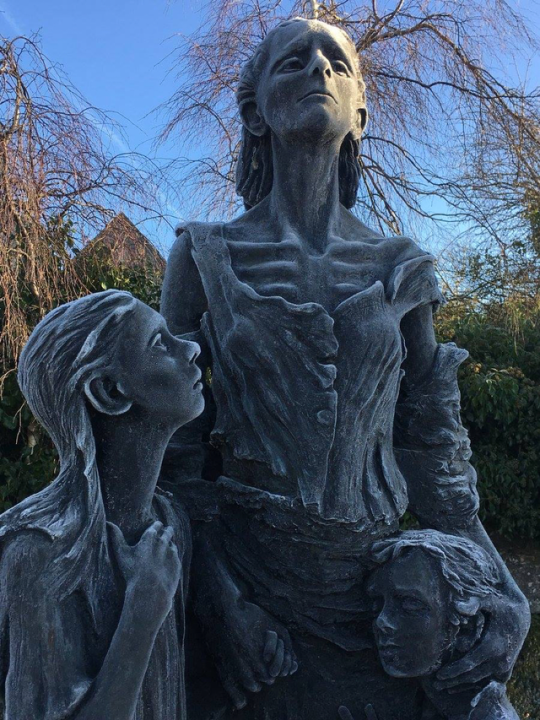
View On WordPress
#Charles Trevelyan#Choctaw Indians#coffin plots#Coffin ships#England#Evictions#Ireland#landlords#Potato Blight#Robert Peel#Starvation#The Great Hunger
21 notes
·
View notes
Note
EXCITED TO SEE YOU AROUND can I hear about The Practice of World-hopping from the WIP tag pls
— @outpost51
Thank you so much ❤️❤️❤️
I'm excited to receive this ask! >D (And also apologies for it being months late lmao)
Anyway, one thing I should mention is that all the faerie portals in my works lead to Ireland. This is because I took inspiration from Irish mythology, where there is significant overlap between people and faeries in the various stories.
Without further ado, here's the entry in question:
A popular past-time for both fae and humans alike, but for different reasons. Fae do it to visit their compatriots living beneath the forts and fairy trees scattered throughout Ireland, as well as to gift or trick the humans living above.
Humans do it to either go ‘home’ for a while, or to go out and get a taste of a slightly different culture. Teens especially find it handy as they can hang out without the contents of their conversation spreading beyond their intended recipients.
This practice has been a reflection of each world’s histories, causing minor pockets of influence on each other’s cultures. It is also a source of conflict and sadness, for within the human settlements of Emaryia, there is an expectation that newcomers should not leave. Leaving is frowned upon because the people are afraid of the repercussions that could happen should the faerie denizens of their world find out that people in the mortal realm know definitively of their existence. This is partially brought upon by pressure from the faeries themselves, who don’t like it when humans leave (without at least being spelled).
For those that know what life in the human world is like, some miss it, others don’t. Those who entered during the famine years were the most susceptible to getting trapped as the food was a godsend to them and their families. These people may have desired to stay a few years or forever, not knowing when things would improve in Ireland again. But a few years turned into decades and longer, as people settled into their new lives and forged new communities.
Similar occurred when the first laws prohibiting Irish culture and language were introduced. Those that entered (though far fewer than during the famine years) were grateful that they could celebrate their culture and customs without worry of being harassed by the British. However, there were some split sentiments amongst people who believed that the right thing to do was return to Ireland and fight to preserve it there. People who thought otherwise were sometimes deemed as ‘cowards’.
From there, a pattern emerged. World-hopping fae copped on rather quickly that they could lure/deceive/manipulate people with great success during periods of historical turmoil. Some of them (the wandering sentinels most notably) were called upon by their underground compatriots when their forts and trees were threatened by planters, farmers and landlords. During the time of the famine, some of the underground fae were afflicted by the same blight affecting the potatoes, and for those that were guarding and blessing the land, their sickness lead to the land suffering too.
It is to be remarked that the fae were generally anti-British, for they found that the Brits had less respect for them as well as the Irish people, and they did not appreciate their liberal use of iron, especially in the Industrial Age. Though some will trick, prank or even harm the native people, they only do so out of playfulness or offence. For a lot of fae it is not their way to spite people for no reason (bar the ones who do have a malicious nature).
Cut to the later times, when English-speakers started rolling in. There was a stigma against them that they were British, or at the very least, that they held pro-British sentiments. When it became more widely known that it was actually a result of the Irish language being exported and erased, there was a sense of horror amongst people. Some people became determined to return and set things right, others decided not to. Those who were more savvy realised that the people of Ireland would not understand Emaryian Gaeilge, due to its slang and other derivations from the original language. While people would walk in with standard fluent or schoolbook Gaeilge, if they spent enough time in the other world, they too would have picked up Emaryian Gaeilge. This version is an amalgamation of the four dialects plus extra words and slang to describe the concepts and experiences unique to humans living there. It is remarkably known for its anachronisms, wildly varied accents and borrowed terms from faerie languages. There are also far less anglicisms in this version.
#caointe na mná#the lady's lament#worldbuilding#fantasy worldbuilding#writeblr#ask game#writing ask game
5 notes
·
View notes
Text
So here is the scientific advancement which might be shown in Ikemen villain and some bit of history
I may have gone overboard because it was fun, so enjoy.
Also if you all think this is a nerd talking you are thinking correct
FIRST AND FOREMOST DINOSAURS SO IT WILLIAM REX THE W - REX, More and more fossils were discovered in 19th century and it was the year of 1842 the term Dinosaur was coined
Charles Darwin the father of evolution published his one of the renowned book 'The Origin Of Species' in 1859. (As a microbiologist this was epic)
Also, In 1866 Gregor Mendel discovered laws of hereditary but it wasn't until 1900 his work accepted
Now again as a microbiology student this makes me very happy, during the years between 1822 - 1895 Louis Pasteur published the Germ theory which proved Germs were the cause of the disease ( Well there were many diseases in victorian era because they believed bathing actually causes more sickness)
Here medicine and surgery made the great advances, and it was also proved Cholera was transmitted by water but they didn't know how. (But it wasn't until 1928 the first antibiotic was discovered)
In 1831 Faradey invented Dynamo.
In the year of 1876 Alexander Graham Bell invented Telephone (It means there would be a scene where MC will call her wink wink)
Safety pins were invented in 1849. And in 1882 Henry Seely invented the very first electric iron
Gas lights were becoming common at houses of well-of people in the 1840s, but by late 1870s working class people had Gaslight at least downstairs they still had to use oil lamps
Gas cookers became common in the 1890s and Joseph swan also invented the Electric light bulb in the year of 1878
Aesthetics were coming to use in surgery first by an American dentist Henry H Morgan in 1849 by using ether. But James Simpson a professor started using chloroform in operations in 1847 (wtf man but cool).
Also another fact, People thought women shouldn't use chloroform during childbirth because childbirth is supposed to be painful but our awesome Queen Victoria said 'Hell nah' in 1853 and who would criticize the queen hence chloroform became a use in childbirth (Men will be men)
Again as biology student this makes me greatly happy, In 1865 Joseph Lister discovered antiseptic surgery.
Cash Register was invented in 1879 and first electric fan was invented in 1886.
19th century was also the time where bicycling was fun. And it was also the time photography became a hobby (hoping a scene in the game where the male leads has MC's photo in his wallet)
In the 19th century many people experimented with machine guns. Hiram Maxim in 1884 invented machine guns and the British army adopted machine guns in 1889
Some Notable historical moments
The matchgirl strike movement took place in 1888 which was lead by Sarah Chapman which was the start to gender equality
In year 1836 slavery was abolished from British Empire but the former slaves were bound as apprentices and they were worked without any pay from their 'owners'.
In 1845 Irish Potato famine began because a disease called potato blight a fungal disease destroyed the crops.
In July of 1848 Public health act was passed, after Cholera outbreak.
1 May 1848 THE GREAT EXHIBITION OPENED FOR THE FIRST TIME. A series of world fair an international exhibition showcasing the achievement of each nation.
In March of 1848 Crimean War began a conflict between Russian Empire and an alliance of French Britain and Ottoman Empire AKA currently Turkish Empire and Sardinian Troops the war came to an end in February 1856 with Treaty of Paris wait part surrender of Russia. Both sides faced a massive death toll as 1.5 millions of soldiers fought and 367,000 soldiers died.
17 November 1869 The opening of the infamous Suez Canal.
2 August 1880 law regarding every child under the age of 10 should have a compulsory education which lead to decrease of child labour and child death.
25 JULY 1889 FOUNDING OF THE WOMEN'S FRANCHISE LEAGUE. Feminism babyyy, Emmeline Pankhrust a women right activist founded this league a political organization that campaigned women should be allowed to vote and which later gave a rise to women suffragatte movements
41 notes
·
View notes
Note
Bunch of answers:
-The thing in the picture is a 𝘚𝘺𝘳𝘪𝘯𝘨𝘢𝘮𝘮𝘪𝘯𝘢 𝘧𝘳𝘢𝘨𝘪𝘭𝘪𝘴𝘴𝘪𝘮𝘢, a kind of Xenophyophorean, which are specialized foraminiferans known for making funky tests (shells) out of sediments. It has no relationship to plants and can't photsynthesize, not sure where you gor that from :)
-SARS viruses have no relationship to the SAR clade. SARS stands for Severe Acute Respiratory Syndrome whereas (T)SAR is just the initials of its majour groups. The name similarity is a complete coincidence.
-S: Stramenopiles is a diverse group of organisms also called Heterokonts (greek for different flagella), as most have at one point of their life cycle 2 flagella, one with and one without "little hairs" on top of the flagellum and the length is also different. Some notable representatives:
• Oomycetes, also known as pseudofungi, which are organisms that look quite a bit like fungi (they form hyphae and micelia) but have no relationship at all. Some are saprophytes whereas others are parasites of plants and fish, including potato blight, the organism that caused the Irish Potato Famine
• Diatoms: Unicellular algae which form very beautifully patterned shells out of silica (so glass), and are very abundant.
• Brown algae: Brown algae have no relationship to plants or other algae. Unlike plants and red and green algae, which acquired their chloroplast from a primary endosymbiosis event with a cyanobacteria, brown algae and many other unicellular algae acquired their chloroplasts by undergoing endosymbiosis with 𝘢𝘯𝘰𝘵𝘩𝘦𝘳 already existing alga. (look into endosymbiosis theory if u have no idea whats going on here)
-A: Alveolata are organisms which have a kind of sacs made of membrane under their main membrane called alveoli. They are also incredibly diverse. They include
• Dinoflagellates: A kind of algae which (in some cases) modified their alveoli to fill them up with cellulose and form a kind of shell. They have funky shapes and are often abundant in the sea. Some of them are known for causing massive blooms which turn the sea red (red tides) and can cause food poisoning if you eat seafood from where a bloom happened.
• Ciliates: Organisms known for having lots of cilia on their bodies, won't go into them because they're very diverse and different, but you can think of a 𝘗𝘢𝘳𝘢𝘮𝘦𝘤𝘪𝘶𝘮 for a typical example of a ciliate.
• Apicomplexans: Mostly parasitic organisms which have a sort of "complex" on the tip of the cell which helps them inject themselves into other cells, this includes the organism which causes malaria, 𝘗𝘭𝘢𝘴𝘮𝘰𝘥𝘪𝘶𝘮.
-R: Rhizaria are amoeboid organisms which often have long pseudopodia called filopodia and are, who would've guessed, also very diverse. The most well known of them are
•Formanifera: A group of mostly marine organisms which form single or multi-chambered shells which can get very complex and are abundant in the sea, so much so that if you know which foraminifera lived in which time periods, you can use their shells in marine sediments to assign a date to them.
• Radiolarians: Organisms which are known for making very intricate and beautiful shells which are very diverse in shape. Look up some of Ernst Haeckel's illustrations of Radiolarians.
-T: Regarding the Telonemia, very few species are described and they aren't very well known, but genetic analysis placed them close to the SAR clade so the acronym is sometimes extended to TSAR
Hope all this helps
THANK YOU SO MUCH MY DUDE THIS IS AN AMAZING ANSWER AHAHAHAHA

^this is why I thought they were related to plants, because both SAR and plants / plant-related things are in this clade, and it says most of the organisms which can photosynthesise are in this clade. But I misunderstood it, thinking it meant most of the organisms that are in this clade can photosynthesise. So, SAR can’t photosynthesise. Is this article wrong to say SAR and plants are related?
Ok so I found this article, which has this tree of life in it-
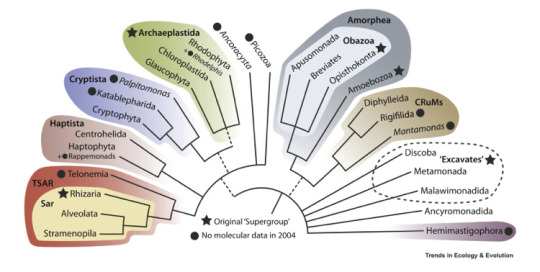
Which suggests plants and TSAR are very loosely related in that they’re closer than eg opisthokonts. And this was in 2020 so is probably fairly close to how things are modernly. (I haven’t fact checked this article. I hope it’s mostly true…)
ANYWAYS
If the xenophyophore makes itself a shell, is that what you can see in the photo? Is the organism itself smaller than the shell or does it fill it? The shell is made of sediment, is it the texture of sediment? All squishy? Or is it shell-ish?
What does saprophyte mean? (Nvm I googled it, it means something which munches upon dead things to survive)
OH DIATOMS SOUND SO COOL!! Kinda like glass sponges but tiny algae!!
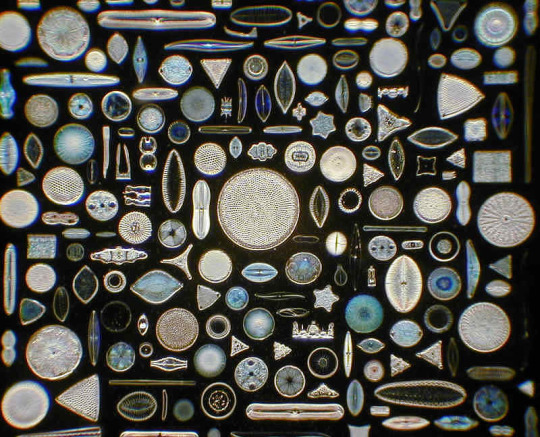
oh wowwww they’re stunning! gorgeous! i love them! beautiful! new favourite organism!
i am thrilled by the fact that plants get their chloroplasts from cyanobacteria. I did not know that. Everything relies on cyanobacteria?!?! Where do cyanobacteria get their chloroplasts from btw?
do the alveoli contain the rest of the cell or are they just empty? what’s in the alveoli? Does that just depend on what specific alveolate it is or do most alveoli have a similar function?
14 notes
·
View notes